- Frymaster Parts Guide - December 31, 2021
- Best Vulcan Fryer Guide For The Commercial Place - November 26, 2021
- Robot Coupe Food Processor Model Guide - November 16, 2021
Do you own a restaurant? If so, then you might know that it is important to have the best fryers for a busy, commercial setting. Frying is an excellent cooking method for a variety of dishes. It can be used to make everything from french fries to fried chicken.
Fryers allow chefs to produce food quickly and efficiently, which is important in commercial kitchens where there are many orders coming in at once. It seals in flavor and leaves your food with a crispy exterior. But it isn’t always easy to decide what kind of fryer you need for your kitchen – especially since they come with so many different features and specifications.
However, the best commercial fryers are designed for heavy-duty use, so they will be able to stand up to the high demands of all different types of restaurant kitchens.
It’s not always easy to know what’s best, but we have taken the time to research some of the top options out there. This blog post will go over some important factors you should consider when purchasing a commercial fryer for your restaurant. We will cover common uses of fryers, what types of restaurants should use which type of fryer, and give examples of popular models available on the market today!
What is a Commercial Fryer?
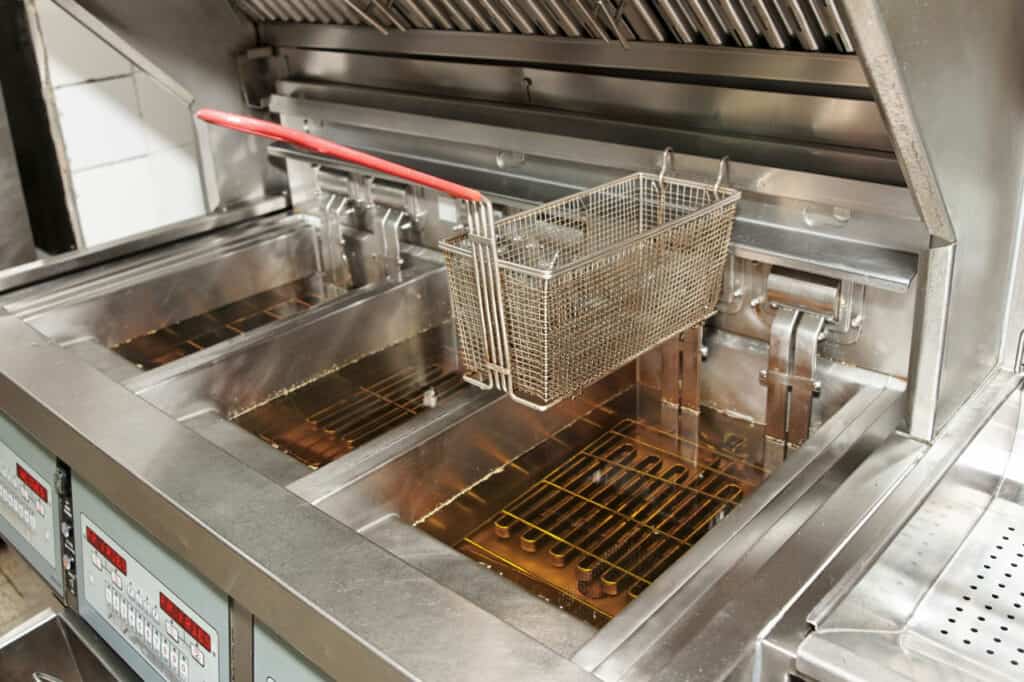
The most common type of commercial fryer is a deep-fat fryer. This is a large pot that can contain 50 gallons or more of cooking oil. It cooks the food by boiling it in the oil at very high temperatures. Afterward, it’s removed from the pot with a basket or other tool. The best commercial fryers have what’s called “a bubbler” attached to prevent any air bubbles from getting into the frying process.
However, deep-fat fryers are not the only type of fryer available to buy these days. You can also get air fryers, which cook food by circulating hot air to create a virtual deep-fryer. Air fryers are safer than using oil, but they are usually much smaller, so often aren’t suitable for large-scale catering establishments.
What Are Commercial Fryers Used For?
Commercial fryers are typically used for deep-fat frying a variety of foods, including meats and vegetables like fries, onion rings, or tempura. They can also be used for frying doughnuts, dumplings, or pastries in some cases.
Fryers are great when you have high volume needs because they get food cooked quickly and efficiently. This is often the case with restaurants that serve lots of fried foods, such as fast food establishments, pubs that serve lots of meals with chips, or Asian cuisine restaurants that serve a lot of fried starters or side dishes as part of their menu options.
Origins of Commercial Fryers
Deep-fat frying can be traced back to the ancient Egyptians. They would cook various meats and vegetables in hot oil to give them flavor. However, it is a cooking method that can now be found all over the world. For many nations, the act of cooking food in animal or vegetable fat has been around for hundreds of years.
Back then it was a quick way to cook food, an easy way to gain nutrients, and a simple way to ensure a tasty dish. These days, it’s become almost the opposite with deep-fat frying being labeled as unhealthy and gaining a reputation of being bad for you. However, it still remains and quick and easy way to cook food, and nobody can deny that deep-fried food isn’t tasty.
What To Consider Before Buying a Commercial Fryer?
There are many things to consider when you are looking for a commercial fryer. Do you need an electric, gas, or propane fryer? What size best suits your needs? How much do the best commercial fryers cost and what is the best way to purchase them?
Here are some of the things you need to ask yourself before you make a purchase:
Fuel type
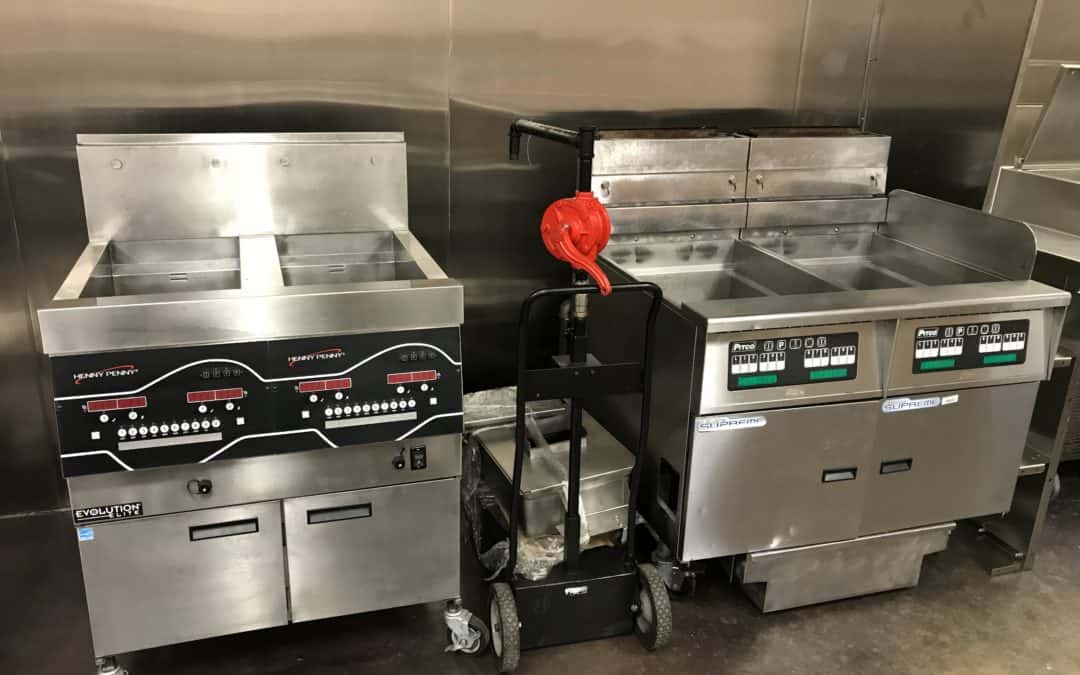
What type of fuel best suits your needs? Do you need an electric fryer, gas fryer, or propane deep-fat fryer with a boiler and wok burner to cook Chinese food? Would you prefer a commercial air fryer to produce healthier dishes? Be sure to consider the energy efficiency too as you won’t want to be paying a fortune to run your fryer.
Size
What size fryer best suits your needs? Fryers range in volume from 20 liters up to over 50 liters. A high-volume restaurant will need a larger commercial deep-fat fryer than someone who only fries small portions of food every once in a while. One way to decide what size is best for you is through the number of pounds or kilograms it can process per hour.
Supplier
What is the best way to purchase your commercial fryers? You will have the option to buy online or go directly to a kitchen supply store or restaurant equipment dealer.
Make sure you get as many quotes as possible before making this big investment and you should try to be entirely sure that it will fit into your budget, but also be of good quality. You’ll want to ensure you buy the highest-quality best commercial fryers that will last for years and work well in your kitchen.
Price
How much do the best commercial fryers cost? Commercial deep-fat frying equipment can be quite expensive, but you need to remember that it’s an investment – what you get out of it will more than likely outweigh the initial cost in the long run.
The best commercial fryers range in price depending on the type and size you need, but a high-quality model will last for years. Be sure to factor price into your decision, and make sure you have a rough idea of your budget before you start shopping to prevent disappointment.
However, also bear in mind that a cheaper appliance could potentially cost more in the long run once you consider repairs, maintenance, and running costs.
Countertop or free-standing?
Whether you opt for a countertop of free-standing fryers will largely depend on the space you have, but also what you’ll be using your commercial fryers for. Some people prefer countertop fryers because they are smaller, and portable, while others like free-standing models to work best with other appliances or free up your workspace to prepare or cook in a restaurant kitchen.
Capacity

How much food do you need your fryer to be able to handle at once? If you’ll be cooking food for a lot of people, make sure your fryers are big enough to handle that much volume. Think how many portions you would usually do at peak service on a weekend and use that as your benchmark. A busy fast food restaurant may need more than one fryer to be able to handle incredibly large volumes of fried foods.
Features
Do you need any additional features? Do you want a speedy heat up time? Do you want a fryer that can do multiple things as well as just fry? Do you want additional safety features? Accessory features such as timers can also come in handy for the best commercial fryers.
Service, Warranty, and Parts
As well as the fryer itself, you’ll also need to bear in mind the upkeep. Do you want a service plan or will you be the one maintaining your fryer? What about parts – do they come with warranties, or is it possible to purchase them separately? Tools like oil filters are often included in deep-fat frying equipment packages while others may not include them, so make sure to double-check what you are getting.
Ease of Cleaning
It’s no secret that deep fat fryers aren’t particularly fun to clean. It can be a messy, tiring job, especially with a fryer that doesn’t have any features to make it more convenient. Things like anti-drip taps, heating elements, or even a water filtration system can help to make commercial fryers easier to clean.
Brand
You may not think brand matters, but when it comes to an investment like a commercial fryer, paying a little extra for a top model can seriously pay off. There’s a wide variety of brands to choose from, but some popular ones include Blodgett, Wolf Range Corporation, Garland, and Imperial.
Manual or Programmable
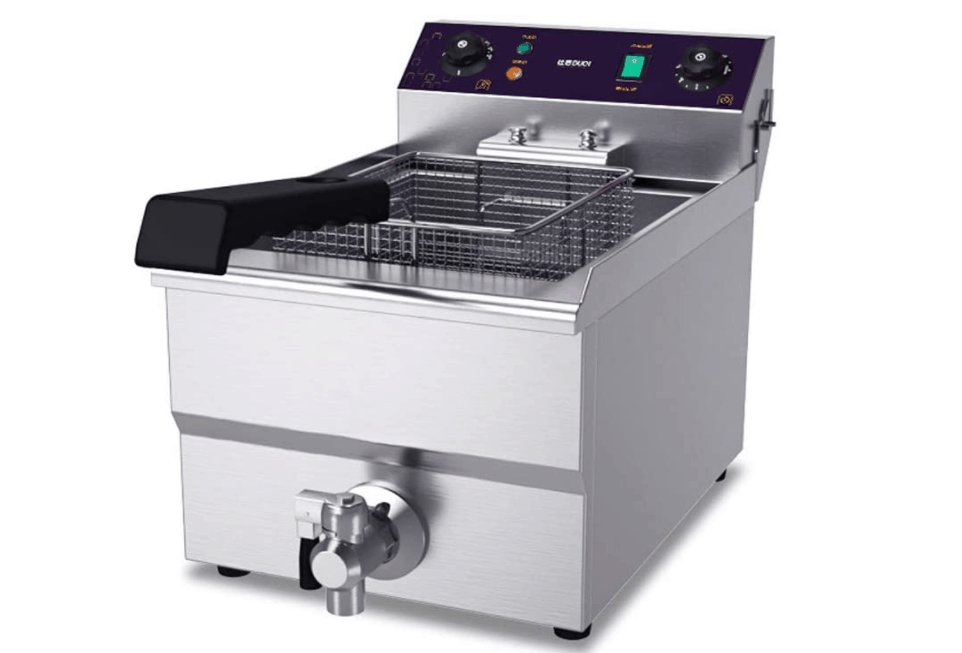
Do you want the best commercial fryers to have a manual feature or optional programmable features? A manual commercial fryer is often best for beginners because it’s easy and intuitive, but if you need more control over your deep fat frying process it may be worth investing in one that can be programmed. Some fryers are even so smart, they automatically lift the food out when it’s cooked! Of course, this type of technology does come with an increased price tag.
Durability
Even with a good warranty, having a fryer that breaks every few months is going to be incredibly annoying and also disruptive to your restaurant. Make sure you pick a durable model and look for a strong, well-constructed design to best suit your needs.
Single Tank or Twin Tank
How many different oil compartments do you need in your fryer? If you’ll be using different oils, a fryer with two tanks will best suit your needs. This is often the case in restaurants where they want to make sure only one type of oil is used for each dish – for vegan restaurants this is particularly helpful. Having two tanks can also mean that you can cook multiple different foods at once, or cook lots of one food which can be incredibly useful for busy restaurants.
Number of Baskets
Multiple baskets also allow you to cook more than one food type at a time, albeit in smaller quantities than having more than one tank. However, if you do have one tank, two baskets can make things much easier than just having one.
What Are The Different Types of Commercial Fryers?
These are some of the most popular types of fryers you could consider for your commercial kitchen:
Gas fryers

Gas fryers are one of the most common types of fryers in a commercial kitchen. They’re best for restaurants or other facilities with extensive cooking needs. This type of commercial fryer can be used to cook everything from french fries and chicken wings to seafood platters – which is why it’s a smart option if you need something versatile. They also tend to get hotter than their electric counterparts, so cook food quicker.
Electric fryers
Electric fryers are also great for larger restaurants. They’re useful for people who are looking to save money on their commercial fryer, and also for those looking for additional safety features as they tend to be safer than traditional gas chip pans.
This type of commercial fryer is typically cheaper and can be installed into your current kitchen, so you don’t have to worry about making additional renovations. It has the added bonus of no gas tank, making it much more portable.
Countertop fryers
Countertop fryers are exactly what they sound like – a fryer that sits on your countertop and usually plugs into the mains. This type of fryer will best suit smaller kitchens or commercial spaces. They are also portable which works great for mobile units or pop-up restaurants.
Free-standing fryers
The opposite of countertop fryers, free-standing fryers are best if you need a permanent fixture. These fryers are usually stationary (although some are more portable than others) and best for kitchens with a lot of cooking needs or plating stations.
They also often have features like storage drawers, multiple burners, or a larger capacity making them best for restaurants with high volumes. You can even buy free-standing fryers with a built-in oven underneath which is great for smaller restaurants that need to save a bit of room.
Induction fryers
Induction fryers are a fairly new and unique type of commercial fryer. Instead of immersing the elements in oil or fat, they cook the food indirectly by heating the tank with induction heat. These fryers are best for restaurants that want a slightly healthier and easier-to-clean option. They are also usually much more efficient.
Air fryers

Air fryers are best for restaurants that want to be a little bit healthier. These commercial fryers use a convection fan and don’t need much oil or fat – instead, the food is cooked by circulating hot air around it. They’re also usually fast-cooking which makes them best for catering jobs where you may not have lots of time available.
The Major Differences Between Gas Fryers and Electric Fryers
Whether to get gas or an electric fryer is one of the most common questions and debates for people buying a commercial fryer. There are a lot of considerations to take into account but we’ll explain the main differences so you can make an informed decision.
Gas fryers heat oil with a burner powered by either natural gas or liquid propane. Gas fryers come in a variety of sizes but the gas flame usually heats a burner located either below or next to the pot and is connected to a gas tank.
In comparison, an electric fryer heats the oil with a heating element that is submerged directly in the oil. The element is powered by a wall outlet or another electrical source and is simply plugged in like you would any other electrical appliance.
Gas fryers are best for restaurants with extensive cooking needs because they’re more versatile – which is why it’s a smart option if you need something that will work well in most kitchen situations. This type of commercial fryer also typically heats faster than an electric fryer.
Electric fryers are best for restaurants that are looking to save money on their commercial fryers. This type of best commercial fryer is typically cheaper and can be installed into your current kitchen, so you don’t have to worry about making additional renovations.
Both of these types of fryers can be either countertop or freestanding.
Advantages of Gas Fryers
- Can reach higher temperatures – gas fryers can reach much higher temperatures than electric fryers, as it’s powered by gas or propane.
- They have faster heat times – they can also reach those temperatures much faster than electric fryers can.
- Will cook food faster – because of their higher temperatures, they will more often than not be able to cook the food quicker than if you were to use an electric fryer.
- More versatile – the best commercial fryers with gas burners can cook anything from french fries to seafood platters.
- Ideal for high volumes – because they’re more powerful and versatile, commercial fryers with a gas burner make them the best option if you need something that will work in most kitchen situations or have a lot of cooking needs. They can be incredibly large and hold volumes of up to 130 pounds!
- Popular – this type of fryer is the most common and popular type seen in commercial kitchens.
The Disadvantages of Gas Fryers
- Less energy-efficient – gas fryers require more energy than electric ones do.
- More expensive to run – with the recent rise in natural gas prices, gas can also be much more costly to replace that electricity, meaning that gas fryers are pricier to run.
- Less portable – hooking a gas fryer up to a gas line makes them much more complicated to move than a simple plug-and-play electrical device.
The Advantages of Electric Fryers
- They are usually cheaper – an electric fryer is typically cheaper than a gas one which makes it better suited for restaurants on a budget.
- Easier installation – some models come ready to install so all you would need to do is plug it into your existing power source – no new wiring or connecting to a gas line is needed.
- Less maintenance – commercial fryers with electric heating elements are less likely to need repairs or replacements than gas ones. They also tend to be easier to clean.
- Portable – Electric fryers are also much more portable than their gas counterparts, as you don’t need to lug around heavy gas tanks.
- Efficient recovery – electric fryers often maintain and recover their temperature faster than gas ones.
The Disadvantages of Electric Fryers
- They are usually smaller – commercial fryers with electric heating elements are best if you need a smaller, more compact option for your restaurant.
- Powercuts will make them useless – in some situations (when the power goes out) this type of commercial deep fat fryer will be rendered useless and won’t work at all. In comparison, the gs fryer will still be able to run.
- Heating elements can be dangerous – these fryers also have heating elements that require constant monitoring and maintenance, which means you don’t want them near anything flammable or with a lot of excess heat.
Commercial Fryer Safety Tips
Hot oil can cause serious injuries if it’s not used correctly, so fryer safety should be a top priority to chefs and all staff members that will be using the machines. Error or lack of training can be disastrous, so here are some commercial fryer safety tips to take into account:
- Make sure you have a lid close – commercial fryers with a lid will help to contain the oil and keep it from spilling or splattering and will also help to contain a fire if the oil was to catch.
- Don’t put wet foods in the fryer – this can cause excess splattering which could potentially catch exposed skin and cause burns.
- Ensure there is a fire extinguisher nearby – having a fire extinguisher nearby will ensure that if the fryer’s oil does catch on fire, you’ll have something to put it out with.
- Never leave a deep fat fryer unattended – this is one of the most important safety tips as leaving an appliance cooking without supervision can lead to fires and spills.
- Don’t overfill your fryer – commercial deep fat fryers with a high volume capacity are suited for cooking larger amounts of food. However, if you overfill them, then you could risk a serious hot oil spill.
- Ensure there is enough ventilation – hot oil will release steam so make sure your commercial deep fat fryer has plenty of room for the steam and air to circulate. This is particularly important if you’re using a gas fryer.
- Know your oil smoke point – once the oil passes its recommended temperature, it will start to smoke and will easily catch fire. Ensure this doesn’t happen by knowing your oil’s smoke point, which is typically between 350° F and 400° F.
- Keep track of your temperatures – deep fat fryers usually have a temperature gauge that should be monitored throughout the cooking process. If it goes too high, turn off the unit and wait for the fryer to cool down before using it again.
- Wear PPE – deep fat fryers should be operated with the best protection possible, so always wear protective gear such as chef whites and protective shoes when using these appliances.
The Top Commercial Fryer Recommendations
The best commercial fryer for restaurants will depend on the type of food you’ll be cooking and the type of establishment you run, but a few of the top recommendations are:
20L Electric Dual Deep Fryer with Timer and Drain Stainless Steel
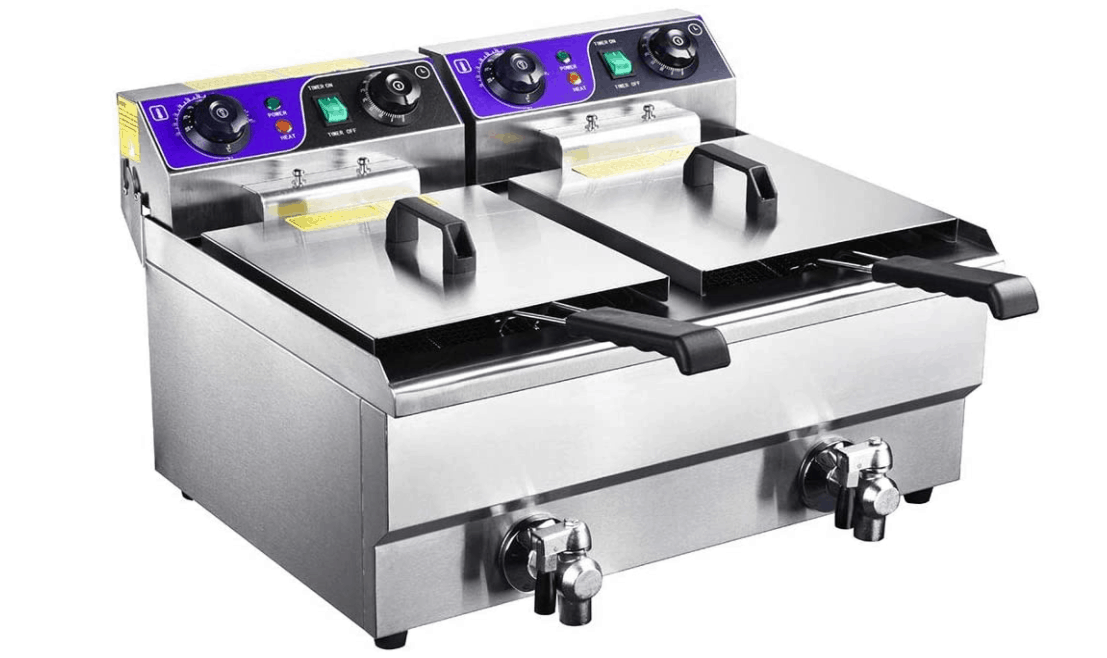
This commercial deep fryer, made of stainless steel, is well-suited for either a commercial restaurant or residential use. Unlike most commercial fryers, the two tanks can work independently of one another, and have their own plug. They also have a decent-sized capacity and are able to hold about 2.5 gallons of oil each.
The tank capacity allows cooks the ability to use one for small orders, or fry multiple foods at once, perfect for small or larger restaurants. It’s also great for catering establishments that serve vegan or vegetarian food because they have used a separate tank purely for this purpose. Every fryer has a built-in oil draining system so the old, used oil can be easily emptied from each tank when they need cleaning.
Pros:
- The dual tank can handle large or small amounts of food
- 2 x 2.5-gallon capacity
- Each tank is independently controlled
- Countertop unit means it’s more portable
- Includes two baskets and 2 lids
Cons:
- Might be too small for some kitchens
Lincat Opus 800 Single Tank Twin Basket Free Standing Electric Filtration Fryer
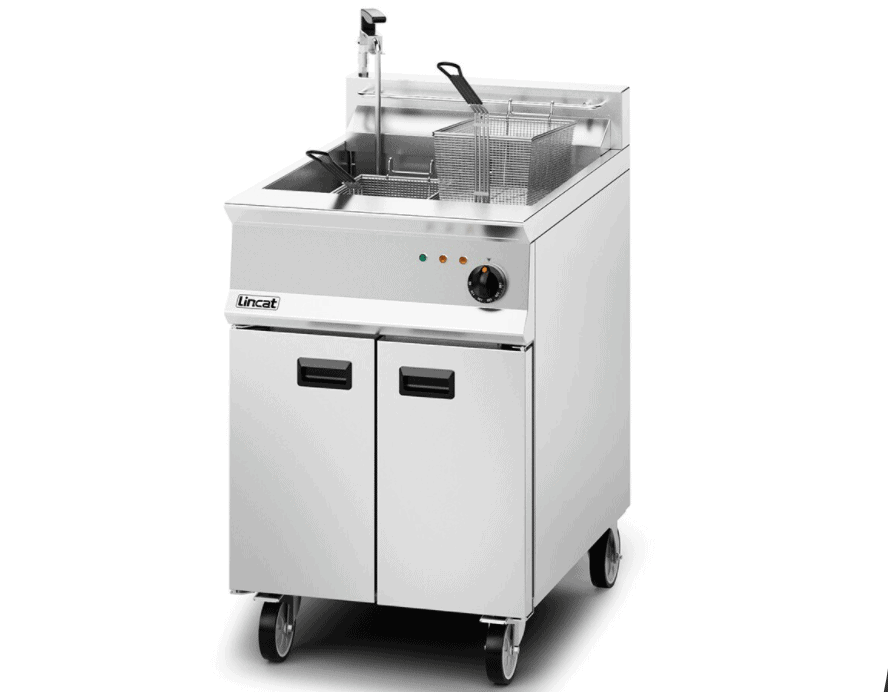
The Lincat Opus 800 Fryer is best for high-volume foodservice operations, such as fast-food restaurants, fish and chip shops, and other forms of quick catering. The drainage system is inbuilt to the appliance, meaning you won’t have any of the hassles that usually come with fitting an external pipe.
The expansive unit is also fitted with a pumping filtration system. This means used cooking oil can be reused, saving money and reducing the risks of foodborne illness. Furthermore, it means your oil will heat up quickly, and be ready to use in 5 minutes or less. The removable battery plates and detachable, dishwasher-safe elements help to make this fryer an extremely easy-to-run, and easy-to-clean machine.
Pros:
- Twin tank can cope with high-volume cooking
- Easy cleaning with an inbuilt drainage system, and dishwasher safe elements
- Includes a pumping filtration system
- Electricity powered
- Wheels make it easily portable
Cons:
- Expensive
- Might be too bulky for some kitchens
Lincat Twin Tank Twin Basket Free Standing Gas Fryer J10
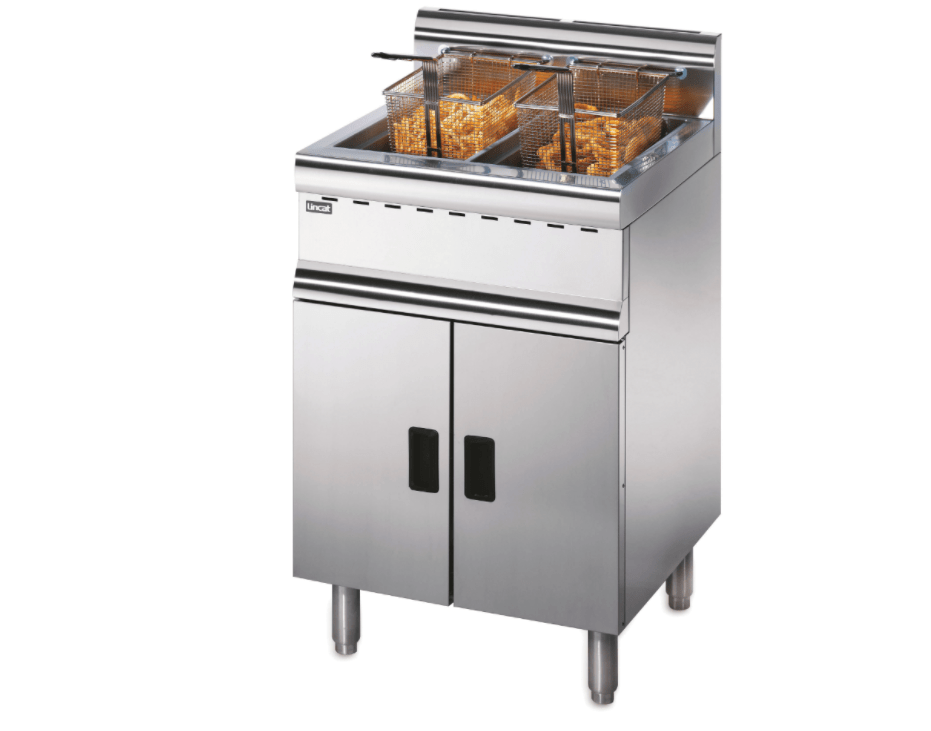
With this Lincat Silverlink 600 gas fryer, you can guarantee the cleanest and crispiest cooking results every time. Its features include a deep cool zone that can collect debris while decreasing your oil consumption. As such, it’s both more efficient and cost-effective than other gas fryers and will be able to go longer between oil changes.
To control your oil temperature, the thermostatic dials on the front of the unit make it a breeze. Both tanks can be controlled independently, ensuring you can fry different types of food at the same time. Safety features like a fail-safe top temperature cut-out help to keep users safe. You can reduce your energy costs too by using a single tank during quieter service periods as each tank is independently controlled.
Pros:
- Deep cool zone reduces oil consumption
- Collects debris
- Thermostatic dials
Cons:
- Less energy-efficient than electric fryers
2500W 6 Liter Electric Countertop Deep Fryer
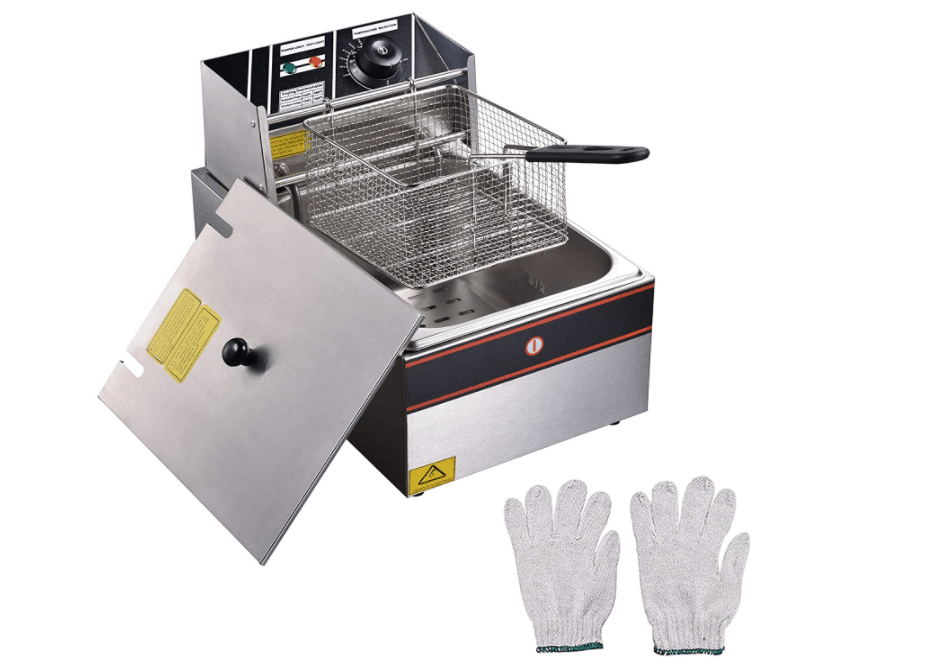
One of the best features about this fryer is its low price, which is somewhat surprising, considering it’s made from high-quality materials and has a pretty solid construction. Other benefits include a high operating temperature and a large 6-liter tank capacity.
However, this unit has some shortcomings that make it less user-friendly than the others on the list because it lacks a fill line for the oil and has some pretty sharp edges. The included lid also doesn’t have any slots for the basket handle, meaning, it’s always slightly raised. But it does include a lid and a basked, which other commercial fryers of this price bracket may not. Overall, it’s very reasonable for the price and quality.
Pros:
- Made from high-quality stainless steel
- Large 6-liter tank capacity
- Basket and lid included in price
- Affordable
Cons:
- The lid doesn’t have slots for the basket handle
- No fill line
- Some edges are rather sharp
FAQs
Question: Which best commercial deep fat fryer should I get?
Answer: If you’re looking for a simple, efficient option with minimum maintenance and cost to run, then electric deep fat fryers are your best bet. If you have more space constraints or need something that can cook larger quantities of food, then gas fryers are your best option. If you’re looking for a deep fat fryer with portability and space-saving qualities, countertop deep fat fryers may be the best option.
Question: How long should a commercial deep fryer last?
Answer: The best commercial deep fat fryer will last for many years if properly maintained. In fact, if it’s well cared for and a good quality machine, it should last around 15 and up to 20 years.
Question: How much does a restaurant deep fryer cost?
Answer: Most professional deep fat fryers are priced within the $1000-$2000 range. It’s important to think about your needs and budget when making this purchase, as some models may be better suited to a particular use case. However, if you’re looking for the best of the best, then a top-of-range deep fryer may sell for over $5,000.
Question: What should I look for in a commercial fryer?
Answer: The best commercial fryers should be easy to use, efficient and economical to run, well-made with quality parts, durable but lightweight enough for you or your staff to move it around easily. Be sure to take into consideration the size, number of tanks, and baskets of the fryers as well as cost, energy efficiency, and durability.
Question: How do commercial deep fryers work?
Answer: This depends on whether you have a gas or electric model. Electric deep fat fryers use the power from an electrical outlet and submerged heating elements to heat up a tank of oil. Gas best commercial deep fat fryers have either one or two burners that are used for heating the cooking tanks. These models typically come with attachments such as covers and baskets so you can cook different foods.
Question: What’s the best oil to deep fry with?
Answer: Generally, commercial deep fat fryers will use vegetable oils. These have a high smoke point and can withstand the higher temperatures needed for frying without smoking or catching fire – this means they’re quite safe to cook with too.
However, you may also come across commercial deep fat fryers that use sunflower oil, coconut oil, canola oil, or lard as the best oil to deep fry in. Lard has a lower smoke point and is best for frying foods such as doughnuts or french fries that cook quickly.
Conclusion
The commercial fryer is a staple in most restaurants. From French fries to fried chicken, the deep-frying process can help make just about any food crispy and delicious! Fryer technology is constantly changing and evolving, so it pays to stay up-to-date with what’s out there for your foodservice establishment.
Remember, whether you choose a gas or electric fryer, make sure it suits all your needs and budget before making your final decision. Take measurements before you start shopping and don’t be sucked in by an extensive feature set if the fundamental need (such as size) isn’t there. We hope our guide helps answer some common questions people ask us all the time–and serve up information that will take your restaurant frying game up a notch!

